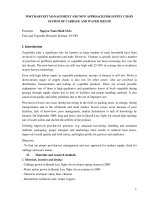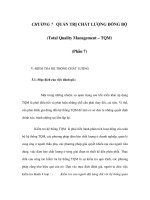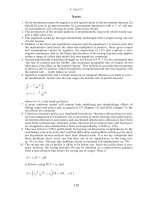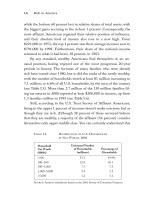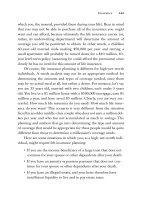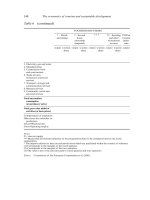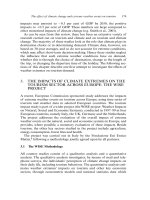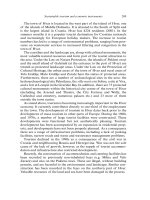SUPPLY CHAIN GAMES: OPERATIONS MANAGEMENT AND RISK VALUATION phần 7 docx
Bạn đang xem bản rút gọn của tài liệu. Xem và tải ngay bản đầy đủ của tài liệu tại đây (656.78 KB, 52 trang )
304 5 AN INTERTEMPORAL FRAMEWORK WITH PERIODIC REVIEW
+
⎟
⎟
⎠
⎞
⎜
⎜
⎝
⎛
−+
∫
−
⎟
⎟
⎠
⎞
⎜
⎜
⎝
⎛
−+
∫
=
∫∫
∫∫∫
+
−
+
++
dtdDDftDdssuXh
dDDftDdssuXhhuJ
tU
t
dssuX
t
t
dssuX
p
t
t
})()()0(
)()()0({),(
1111
0
)()0(
0
1111
0
)()0(
0
0
0
τ
⎥
⎦
⎤
⎢
⎣
⎡
+
∫
T
dttXhE
τ
))(( (5.7)
Using Propositions 5.1-5.2, the last term in (5.7) can be readily determined
as a sum of J
det
obtained for each particular case multiplied by the correspon-
ding probability. Specifically, from Proposition 5.1 for X()
≥
0, we have
J
det
=
))(
2
))(((
2
2
2
τττ
−−−
+
T
D
TXh
, when D
2
τ
τ
−
<
T
X )(
and J
det
=
2
2
2
2
)(
D
X
h
τ
+
when
2
)(
T
X
−
τ
τ
∫
≥−
τ
τ
0
1
0)( ddssu
occurs with probability
∫
∫
+
τ
τ
0
)()0(
0
111
)(
dssuX
dDDf
, we conclude
=
⎥
⎦
⎤
⎢
⎣
⎡
∫
≥
T
X
dttXCE
τ
τ
))((
0)(
2122
2
2
)(
0
2
)()0(
0
11
)())(
2
))((([)(
0
dDDDfT
D
TXhDf
T
X
dssuX
τττ
τ
τ
τ
τ
−−−
∫
∫∫
−
+
+
+
1212
2
2
)(
2
])(
2
)(
dDdDDDf
D
X
h
U
T
X
τ
τ
τ
∫
−
+
.
Similarly, from Proposition 5.2 we have for X()<0:
=
⎥
⎦
⎤
⎢
⎣
⎡
∫
<
T
X
dttXCE
τ
τ
))((
0)(
2122
2
2
)(
0
)()0(
11
)(
)(2
)(
[)(
0
dDDDf
DU
X
hDf
T
X
U
U
dssuX
−
∫
∫∫
−
+
−
+
τ
τ
τ
τ
τ
-
+=
τ
)0()( XX≤ D
. Taking into account equation (5.1),
, which by definition of the demand dis
tribution f(.),
5.1 TWO-PERIOD INVENTORY OUTSOURCING 305
12122
2
2
)(
])())(
2
))((( dDdDDDfT
DU
TXh
U
T
X
U
τττ
τ
τ
−
−
+−−
∫
−
+
−
.
Consequently,
=
⎥
⎦
⎤
⎢
⎣
⎡
∫
T
dttXCE
τ
))((
⎥
⎦
⎤
⎢
⎣
⎡
∫
≥
T
X
dttXCE
τ
τ
))((
0)(
+
⎥
⎦
⎤
⎢
⎣
⎡
∫
<
T
X
dttXCE
τ
τ
))((
0)(
. (5.8)
Let us introduce a new variable, Y(t):
)()( tutY =
&
, Y(0)=X(0),
τ
≤
≤
t0
. (5.9)
Then, by substituting
∫
−+=
τ
ττ
0
1
)()0()( DdssuXX
=Y()-D
1
into (5.8) and
taking into account (5.9), the objective function (5.7) takes the following
form
() ()
))((})()()()({),(
1111
)(
0
1111
)(
0
1
τϕ
τ
YdtdDDftDtYhdDDftDtYhhuJ
U
t
tY
t
tY
p
+−−−=
∫∫∫
−++
,(5.10)
where
=
))((
τ
ϕ
Y
2122
2
2
1
)(
0
2
)(
0
11
)())(
2
))()((([)(
1
dDDDfT
D
TDYhDf
T
DY
Y
ττττ
τ
ττ
τ
τ
−−−−
∫∫
−
−
+
+
12122
2
2
1
)(
2
])(
2
))((
1
dDdDDDf
D
DY
h
U
T
DY
ττ
τ
ττ
−
∫
−
−
+
+
2122
2
2
1
)(
0
)(
1
)(
)(2
))((
[)(
1
dDDDf
DU
DY
hDf
T
DY
U
U
Y
−
−
∫∫
−
−
+
−
ττ
τ
ττ
τ
τ
12122
2
2
1
)(
])())(
2
))()(((
1
dDdDDDfT
DU
TDYh
U
T
DY
U
ττττ
τ
ττ
−
−
+−−−
∫
−
−
+
−
. (5.11)
We thus proved the following theorem.
Theorem 5.1. Control u(t), which is optimal for deterministic problem
(5.5) when
Tt ≤≤
τ
and for deterministic problem (5.2),(5.9)-(5.11) when
τ
<≤ t0
is optimal for stochastic problem (1)-(4) for
Tt
≤
≤
0
.
Problem (5.9)-(5.11) and (5.2) is a canonical, deterministic, optimal con-
trol problem which can be studied with the aid of the maximum principle.
Since all constraints are linear, the maximum principle-based optimality con-
ditions are not only necessary but also sufficient if the objective function
306 5 AN INTERTEMPORAL FRAMEWORK WITH PERIODIC REVIEW
(5.10) is convex. Moreover, this problem has a unique solution if the
objective function is strictly convex, which evidently holds if
0
)(
1
>
∂
∂
D
DF
and
0
))((
2
2
>
∂
∂
Y
Y
τϕ
.
Accordingly, we next use the maximum principle by first constructing the
Hamiltonian
() ()
)()()()()()(
111
)(
111
)(
0
1
tutdDDftDtYhdDDftDtYhH
U
t
tY
t
tY
ψ
+−+−−=
∫∫
−+
, (5.13)
where the co-state variable )(t
ψ
is determined by the co-state differential
equation
)(
)(
tY
H
t
∂
∂
−=
ψ
&
=
−−+
−
⎟
⎠
⎞
⎜
⎝
⎛
+ h
t
tY
Fhh
)(
)(
11
(5.14)
with boundary (transversality) condition
)(
))((
)(
τ
τϕ
ψ
Y
Y
T
∂
∂
−=
. (5.15)
According to the maximum principle, the optimal control maximizes the
Hamiltonian, that is,
⎪
⎩
⎪
⎨
⎧
=∈
<
>
=
.0)( if ],,0[
;0)( if ,0
;0)( if ,
)(
tUb
t
tU
tu
ψ
ψ
ψ
(5.16)
We resolve the ambiguity of the third condition from (5.16) in the follow-
ing proposition.
()
−+
−
+
=
hh
h
F
1
1
β
and 0)(
=
t
ψ
at a measurable inter-
val,
τ
. If
≤
U, then Y(t)=t and
β
=
)(tu
for
τ
∈
t
.
Proof: Differentiating the condition 0)(
=
t
ψ
over
τ
and taking into account
(5.14), we find
−+
−
+
=
⎟
⎠
⎞
⎜
⎝
⎛
hh
h
t
tY
F
1
1
)(
. (5.17)
Thus
t
tY )(
=
β
and, therefore, Y(t)=t and
β
== )()( tutY
&
for
τ
∈
t
.
We next introduce two switching points t
a
and t
b
which satisfy
dth
t
ttUt
Fhh
aa
t
a
]
)(
)[(
11
−−+
−
⎟
⎠
⎞
⎜
⎝
⎛
−+
+
∫
β
τ
)()(
)(
))((
aa
tUtY
Y
Y
−+=
∂
∂
−=
τβτ
τ
τϕ
, (5.18)
(5.12)
Proposition 5. 3. Let
5.1 TWO-PERIOD INVENTORY OUTSOURCING 307
dth
t
t
Fhh
b
t
b
])[(
11
−−+
−
⎟
⎠
⎞
⎜
⎝
⎛
+
∫
β
τ
b
tY
Y
Y
βτ
τ
τϕ
=
∂
∂
−=
)(
)(
))((
(5.19)
respectively and assume that the production system has sufficient capacity,
i.e.,
≤
U.
Similar to the optimal solution for the second period, an optimal solu-
tion for the first period can be structured into a number of cases depending
on the parameters of the production system. We study first two general cases
of a non-negative initial inventory level which are described in the follow-
ing two propositions (see Figures 5.1 - 5.4).
Proposition 5.4. Let X(0) ≥ 0 and
β
τ
<
)0(X . If
β
)0(X
t
a
> and
0
)(
))((
)()(
<
∂
∂
−+=
aa
tUtY
Y
Y
τβτ
τ
τϕ
, then the optimal production control is
u(t)=0 for
β
)0(
0
X
t <≤
, u(t)= for
a
tt
X
<≤
β
)0(
, and
Utu
=
)( for
τ
≤
≤
tt
a
.
Proof: Consider the following solution for the state variables
u(t)=0, Y(t)=X(0) for
β
)0(
0
X
t <≤
; u(t)=,
Y(t)= t for
a
tt
X
<≤
β
)0(
; Utu
=
)( , Y(t)= t
a
+U(t-t
a
) for
τ
≤
≤
tt
a
and co-state variables
∫
−−+
−
⎟
⎠
⎞
⎜
⎝
⎛
+−=
β
ψ
)0(
11
]
)0(
)[()(
X
t
dth
t
X
Fhht
for
β
)0(
0
X
t <≤
;
0)(
=
t
ψ
for
a
tt
X
<≤
β
)0(
;
∫
−−+
−
⎟
⎠
⎞
⎜
⎝
⎛
−+
+=
t
t
aa
a
dth
t
ttUt
Fhht ]
)(
)[()(
11
β
ψ
for
τ
≤
≤
tt
a
.
If this solution is feasible and satisfies optimality conditions (5.16), then it
is optimal.
The feasibility,
β
)0(X
t
a
> and
0
)(
))((
)()(
<
∂
∂
−+=
aa
tUtY
Y
Y
τβτ
τ
τϕ
, is imposed by
the statement of this proposition. The optimality conditions are verified
straightforwardly. Specifically, it is easy to observe that from
β
τ
<
)0(X and
308 5 AN INTERTEMPORAL FRAMEWORK WITH PERIODIC REVIEW
()
−+
−
+
=
hh
h
F
1
1
β
, we have
0
)0(
)(
11
<−
⎟
⎠
⎞
⎜
⎝
⎛
+
−−+
h
t
X
Fhh
for
β
)0(
0
X
t <≤
and
thus
∫
−−+
−
⎟
⎠
⎞
⎜
⎝
⎛
+−=
β
ψ
)0(
11
]
)0(
)[()(
X
t
d
t
h
t
X
Fhht
>0, i.e., the second optimality condition,
−
a
dth ]
>0 for
t
a
a
tt
X
<≤
β
)0(
and therefore u(t)=.
Note that the optimal control described in Proposition 5.4 consists of three
different trajectories. If the feasibility requirement
0
)(
))((
)()(
<
∂
∂
−+=
aa
tUtY
Y
Y
τβτ
τ
τϕ
is not met, then the third trajectory implies no-production instead of pro-
duction at maximum rate as stated in the following proposition.
Proposition 5.5. Let X(0)
≥
0 and
β
τ
<
)0(X
. If
β
)0(X
t
b
> and
0
)(
))((
)(
>
∂
∂
=
b
tY
Y
Y
βτ
τ
τϕ
, then the optimal production control is
u(t)=0 for
β
)0(
0
X
t <≤
, u(t)= for
b
tt
X
<≤
β
)0(
, and
u(t)=0 for
τ
≤
≤
tt
b
.
Similarly we can state the two general cases when the initial inventory
level is negative as shown in the following two propositions (see Figures
5.3-5.4).Proofs for Proposition 5.5 as well as for the next two propositions
are similar and therefore omitted. Of course, special cases readily emanate
from Propositions 5.4 and 5.5 when one of the switching points or both
vanish.
Proposition 5.6. Let X(0)<0 and )()0(
β
τ
−
−
> UX . If
β
−
−
>
U
X
t
a
)0(
and
0
)(
))((
)()(
<
∂
∂
−+=
aa
tUtY
Y
Y
τβτ
τ
τϕ
, then the optimal production control is
∫
−+
−
⎟
⎠
⎞
⎜
⎝
⎛
−+
+=
t
t
aa
t
ttUt
Fhht
)(
)[()(
11
β
ψ
u(t)=0, from (5.16) holds. Similarly,
< t ≤
τ
and thus the
first optimality condition, u(t)=U, from
(5.16) holds. The third condition
from (5.16) is explicit,
ψ
(t) = 0 for
5.1 TWO-PERIOD INVENTORY OUTSOURCING 309
u(t)=U for
β
−
−
<≤
U
X
t
)0(
0
, u(t)= for
a
tt
U
X
<≤
−
−
β
)0(
, and
Utu
=
)( for
τ
≤
≤
tt
a
.
Figure 5.1. Optimal control over the first period for X(0)>0 when
0
)(
))((
<
∂
∂
τ
τϕ
Y
Y
Proposition 5.7. Let X(0)<0 and )()0(
β
τ
−
−
> UX . If
β
−
−
>
U
X
t
b
)0(
and
0
)(
))((
)(
>
∂
∂
=
b
tY
Y
Y
βτ
τ
τϕ
, then the optimal production control is u(t)=U for
β
−
−
<≤
U
X
t
)0(
0
, u(t)= for
b
tt
U
X
<≤
−
−
β
)0(
, and u(t)=0 for
τ
≤
≤
tt
b
.
U
t
X(0)/ t
a
u(t)
Y(t)
)(t
ψ
a
310 5 AN INTERTEMPORAL FRAMEWORK WITH PERIODIC REVIEW
Figure 5.2. Optimal control over the first period for X(0)>0 when
0
)(
))((
>
∂
∂
τ
τϕ
Y
Y
Figure 5.3. Optimal control over the first period for X(0)<0 when 0
)(
))((
<
∂
∂
τ
τϕ
Y
Y
u(t)
)(t
ψ
Y(t)
t
b
X(0)/
b
U
t
-X(0)/(U-) t
a
u(t)
Y(t)
)(t
ψ
a
5.1 TWO-PERIOD INVENTORY OUTSOURCING 311
Figure 5.4. Optimal control over the first period for X(0)<0 when
0
)(
))((
>
∂
∂
τ
τϕ
Y
Y
Example 5.1
In this example we derive explicit equations for
)(
))((
)(
τ
τϕ
ψ
Y
Y
T
∂
∂
−=
and
))((
τ
ϕ
Y
. The example is motivated by the goods which have a short life-
cycle during which it is likely that the demand has a single realization, i.e.,
D
1
=D
2
, which is estimated by time of inventory review. Therefore, after
deriving a general optimal solution, we focus on the example which is
based on the conditional density function
f
2
(D
2
|D
1
)=(D
2
-D
1
),
where (D
2
-D
1
) is a Dirac function. When substituting this conditional dis-
tribution function into equation (5.11),
))((
τ
ϕ
Y
simplifies to:
t
b
-X(0)/(U-)
u(t)
)(t
ψ
Y(t)
312 5 AN INTERTEMPORAL FRAMEWORK WITH PERIODIC REVIEW
=))((
τ
ϕ
Y
1
2
1
12
)(
0
11
))(
2
))()((()( dDT
D
TDYhDf
T
Y
ττττ
τ
−−−−
+
∫
+
1
1
2
1
)(
)(
211
2
))((
)( dD
D
DY
hDf
Y
T
Y
ττ
τ
τ
τ
−
∫
+
+
1
1
2
1
)(
)(
11
)(2
))((
)( dD
DU
DY
hDf
T
T
U
T
Y
Y
−
−
∫
−
+
−
ττ
ττ
τ
τ
1
2
1
1
)(
11
))(
2
))()((()( dDT
DU
TDYhDf
U
T
T
U
T
Y
ττττ
τ
τ
−
−
+−−−
∫
−
+
−
. (5.20)
This affects only boundary condition (5.15) as follows
)(
))((
)(
τ
τϕ
ψ
Y
Y
T
∂
∂
−=
=(
2
2
1
)(
2
)(
)
)(
(
τ
τ
τ
−
+
T
T
Y
T
Y
fh
+
1
)(
0
11
)()( dDThDf
T
Y
τ
τ
−
+
∫
-
-
2
2
1
)(
2
)(
)
)(
(
τ
ττ
−
+
T
T
Y
T
Y
fh
+
1
1
1
)(
)(
11
))((
)( dD
D
DY
hDf
Y
T
Y
ττ
τ
τ
τ
−
∫
+
+
+
))((
2
)(
)
)(
(
2
2
1
ττ
τ
τ
τ
YU
T
T
T
T
U
T
Y
fh −
−
−
+
−
+
1
1
1
)(
)(
11
)(
)( dD
DU
DY
hDf
T
T
U
T
Y
Y
−
−
∫
−
+
−
ττ
ττ
τ
τ
))((
2
)(
)
)(
(
2
2
1
ττ
τ
τ
τ
YU
T
T
T
T
U
T
Y
fh −
−
−
+−
−
1
)(
11
)()( dDThDf
U
T
T
U
T
Y
τ
ττ
−−
∫
−
+
−
).
That is,
)
)(
()()(
12
T
Y
FThT
τ
τψ
−−
+
1
1
1
)(
)(
112
)(
)( dD
D
DY
Dfh
Y
T
Y
ττ
τ
τ
τ
−
−
∫
+
-
1
1
1
)(
)(
11
)(
)( dD
DU
DY
Dfh
T
T
U
T
Y
Y
−
−
−
∫
−
+
−
ττ
τ
τ
τ
τ
))
)(
(1)((
1
T
T
U
T
Y
FTh
τ
τ
τ
−
+−−+
−
. (5.21)
The distributor handles at each time point t all inventory-related operations.
For each time unit of this service, the distributor charges the producer per
Distributor’s Problem
5.1 TWO-PERIOD INVENTORY OUTSOURCING 313
item holding cost, h
+
(t).The distributor’s goal is to minimize his expected
cost (or, which is the same in this case, to maximize his profit):
⎥
⎦
⎤
⎢
⎣
⎡
−=
∫
+++
++
T
h
d
h
dttXthmEhuJ
0
)())((min),(min (5.22)
s.t.
(5.1)-(5.2)
Mthm ≤≤
+
)( , (5.23)
where m is the distributor’s marginal cost and M is the maximum inventory
holding cost so that the producer will not explore the market for another
competing distributor.
Using the same approach as in the previous section, we first analyze the
deterministic part of the problem, i.e., when there is only one period to go.
Consider time interval [, T]. At this interval, problem (5.1)-(5.2), (5.22)
and (5.23) takes the following deterministic form:
min)()(
2det
→−=
∫
++
T
dttXhmI
τ
(5.24)
s.t.
(5.1),(5.2) and (5.23).
An optimal solution for problem (5.24) and thus the best distributor’s
response to any producer’s production and inventory policy is straightfor-
ward. Indeed, the dynamic equation (5.1) depends neither on h
+
(t) explic-
itly, nor the switching points in Propositions 5.1 and 5.2. As a result, the
optimal solution for this problem is trivial, which is to charge the producer
for handling the inventories as much as possible,
Mh =
+
2
. Similar to Pro-
positions 5.1 and 5.2, the objective function value is then
I
det
=0 if
0)( ≤
τ
X
; I
det
=
))(
2
))(()((
2
2
2
τττ
−−−−
+
T
D
TXhm ,
if )()(
2
τ
τ
−
> TDX ,
I
det
=
2
2
2
2
)(
)(
D
X
hm
τ
+
− if )()(0
2
τ
τ
−
≤
<
TDX . (5.25)
In what follows, we summarize these observations with the aid of the fact
that the optimal production policy, u(t), from Propositions 5.1 and 5.2 can
be presented in a time-dependant (integral) feedback form, *(X(),t).
Deterministic Component of the Problem
314 5 AN INTERTEMPORAL FRAMEWORK WITH PERIODIC REVIEW
5.2 GAME ANALYSIS
The game between the producer and the distributor is as follows. At each
period, the distributor selects a price, h
+
, to charge the producer for handling
inventories during one period while the producer decides how many products
u(t) to produce and outsource (store) X
+
(t) at each time point t of period.
The manufacturer then produces the products and the distributor handles
the surplus.
We consider different relationships between the players – the supply chain
parties. The equal strength of the parties characterizes one case in which
the decisions are made simultaneously (Nash strategy). The other cases are
due to the presence of a leader (Stackelberg strategy). If the leader is a dis-
tributor who sets a charge for carrying inventories, then the manufacturer
is a follower who responds to the charge with a production policy and,
consequently, an inventory outsourcing policy as well. A reverse situation
is also possible, when the manufacturer is the leader. Since an optimal solu-
tion of the producer does not depend on the distributor’s charge at the last
period (see Propositions 5.1 and 5.2), the equilibrium at this period is straight-
forward, regardless of leadership in the supply chain, as stated in the fol-
lowing proposition.
Proposition 5.8. Given inventory level X(), equilibrium in a two-period
inventory outsourcing differential game for
Tt
≤
≤
τ
does not depend on
whether there is a leader in the supply chain or not. Specifically, a Nash
equilibrium as well as a Stackelberg equilibrium when the distributor is
the leader and when the producer is the leader are described by the same
unique production feedback policy u(t)=*(X(),t),
⎪
⎪
⎪
⎪
⎪
⎪
⎪
⎩
⎪
⎪
⎪
⎪
⎪
⎪
⎪
⎨
⎧
≤≤−−≤
−
−<≤≤<−−
≤≤
−
−≤<−−
≤≤+−≤≤
+<≤−≤≤
≤≤−>
=
TtTUDXifU
DU
X
tXTUDifU
Tt
DU
X
XTUDifD
Tt
D
X
TDXifD
D
X
tTDXif
TtTDXif
tX
τττ
τ
ττττ
τ
τττ
τ
τττ
τ
ττττ
τττ
τπ
),)(()(,
;
)(
,0)())((,
;
)(
,0)())((,
;
)(
),()(0,
;
)(
),()(0,0
;),()(,0
)),((*
2
2
2
2
22
2
22
2
2
2
and inventory holding price
Mh =
+
2
.
Note, that if full commitment and no flexibility characterize the contract
between the manufacturer and the distributor, then the inventory holding
5.2 GAME ANALYSIS 315
price cannot be reconsidered at the inventory review point. Thus the sto-
chastic component of the problem determines the equilibrium price, which
will be
++
=
12
hh
instead of
Mh =
+
2
.
Given an optimal solution over the second interval [ ,T ], we are now inter-
ested in an optimal solution and the best distributor’s response over time
for the first interval [0, ] of problem (1),(2), (22) and (23). Applying con-
ditional expectation to the objective function (5.22) we obtain:
⎥
⎦
⎤
⎢
⎣
⎡
−+
⎟
⎟
⎠
⎞
⎜
⎜
⎝
⎛
−+
∫
−=
∫∫∫∫
++
+
++
Tt
t
dssuX
d
dttXhmEdtdDDftDdssuXhmhuJ
t
τ
τ
)()()()()0()(),(
2
0
1111
0
)()0(
0
1
0
,(5.26)
where
⎥
⎦
⎤
⎢
⎣
⎡
−
∫
++
T
dttXhmE
τ
)()(
2
=
2122
2
2
)(
0
)()0(
0
211
)())(
2
))((([))((
0
dDDDfT
D
TXhmDf
T
X
dssuX
τττ
τ
τ
τ
τ
−−−
∫
−
∫∫
−
+
+
+
1212
2
2
)(
])(
2
)(
dDdDDDf
D
X
U
T
X
τ
τ
τ
∫
−
. (5.27)
Taking into account equation (5.9) and
∫
−+=
τ
ττ
0
1
)()0()( DdssuXX
=Y()-D
1
,
objective function (5.26) transforms into
()
))(()()()(),(
0
1111
)(
0
1
τη
τ
YdtdDDftDtYhmhuJ
t
tY
d
+−−=
∫∫
++
+
→
1
min
h
(5.28)
where
=))((
τ
η
Y
2122
2
2
1
)(
0
)(
0
211
)())(
2
))()((([))((
1
dDDDfT
D
TDYhmDf
T
DY
Y
ττττ
τ
ττ
τ
τ
−−−−−
∫∫
−
−
+
+
12122
2
2
1
)(
])(
2
))((
1
dDdDDDf
D
DY
U
T
DY
ττ
τ
ττ
−
∫
−
−
. (5.29)
As with Theorem 5.1, we conclude with the following theorem.
Stochastic Component of the Problem
316 5 AN INTERTEMPORAL FRAMEWORK WITH PERIODIC REVIEW
Theorem 5.2. Control h
+
(t), which is optimal for deterministic problem
(5.24) when
Tt ≤≤
τ
and for deterministic problem (5.2), (5.9), (5.23),
(5.28) and (5.29) when
τ
<
≤
t0 is optimal for stochastic problem (5.1)-
(5.2), (5.22) and (5.23) for
Tt
≤
≤
0 .
Similar to the deterministic case, when
Tt
≤
≤
τ
, we readily observe
from (5.1),(5.28)-(5.29) that the inventory dynamics do not depend on
price
+
1
h
unless the distributor is the Stackelberg leader and is therefore
able to take into account the best producer’s response to a price he offers.
Since function (5.28) is linear in
+
1
h
, in cases where there are no leaders or
the producer is the leader, the optimal distributor’s response is again to
charge the producer as much as possible for handling his inventories,
Mh =
+
1
.
Proposition 5.9. Given inventory level X(0), if
0
))((
2
2
>
∂
∂
Y
Y
τϕ
,
0
)(
1
>
∂
∂
D
DF
,
and that the supply chain has no leader or the producer is the leader, then
the production policy determined by Propositions 5.4-5.7 and inventory
holding price
Mh =
+
1
constitute a unique Nash equilibrium as well as a
Stackelberg equilibrium under the producer’s leadership in the two-period
differential inventory outsourcing game for
τ
≤
≤
t0 .
The situation changes if a large distributor is the leader and the manu-
facturer is the follower. Then the optimal manufacturer’s production policy
defined in Propositions 5.4-5.7 is substituted into the distributor’s problem
(5.2), (5.9),(5.23), (5.28) and (5.29). This is to say that, in such a case, the
distributor assumes production u(t) to be endogenous. Propositions 5.4-5.7
identify four general types of optimal solutions and a number of sub-cases.
These cases depend on the system parameters and whether the manufac-
turer has an initial shortage of products or a surplus. Each of these cases
thus induces a corresponding equilibrium. To avoid awkward expressions,
we here focus only on two cases, both of which are due to the standard
assumption that the initial inventory level is zero, X(0)=0. Then the first
switching point in Propositions 5.4-5.7 vanishes and the best producer’s
response takes the following form.
Proposition 5.10. The optimal production policy is:
Low demand expectation
if
0)(
)(
))((
=
−
∂
∂
≤
τ
τ
τϕ
τ
Y
Y
Y
h
, then u(t)= ,0for 0
τ
≤
≤
t
5.2 GAME ANALYSIS 317
if
τ
τ
τϕ
τ
−
=
<
∂
∂
h
Y
Y
Y 0)(
)(
))((
but
0
)(
))((
)(
>
∂
∂
=
βττ
τ
τϕ
Y
Y
Y
, then u(t)= for
b
tt <≤0
and u(t)=
,for 0
b
τ
≤
≤
tt
Average demand expectation
if
0
)(
))((
)(
=
∂
∂
=
βττ
τ
τϕ
Y
Y
Y
, then u(t)= for
τ
≤
≤
t0 ;
High demand expectation
if
ττ
τ
τϕ
τ
UY
Y
Y
hUFhh
=
−−+
∂
∂
−>−+
)(1
)(
))((
))()((
but
0
)(
))((
)(
<
∂
∂
=
βττ
τ
τϕ
Y
Y
Y
,
then u(t)= for
a
tt
<
≤0 and u(t)=U for ,
τ
≤
≤
tt
a
otherwise
if
ττ
τ
τϕ
τ
UY
Y
Y
hUFhh
=
−−+
∂
∂
−≤−+
)(1
)(
))((
))()((
, then u(t)=U for
τ
≤≤ t0 .
To find the Stackelberg equilibrium, we substitute (5.9) along with the
first production policy from Proposition 5.10 (induced by a low demand
expectation) into (5.28) and (5.29). This converts the dynamic problem (5.2),
(5.9), (5.23), (5.28) and (5.29) into a static one, to which we can apply the
first-order optimality condition,
0
1
=
∂
∂
+
h
J
d
. (5.30)
Let us denote a solution of equation (5.30) in
+
1
h
as . We thus conclude
with the following proposition.
Proposition 5.11. Given inventory level X(0)=0,
0
)(
1
>
∂
∂
D
DF
,
0
)(
2
2
>
∂
∂
Y
t
b
βϕ
and the distributor is the leader in the supply chain. If
0
)(
2
1
2
>
∂
∂
+
h
J
d
,
τ
ϕ
−
<
∂
∂
h
Y
)0(
,
0
)(
>
∂
∂
Y
βτϕ
and Mm
≤
≤
γ
, then the production policy
u(t)= for
b
tt <≤0
, u(t)= ,for 0
b
τ
≤
≤
tt and inventory holding price
+
1
h = constitute a unique Stackelberg equilibrium in the two-period dif-
ferential inventory outsourcing game for
τ
≤
≤
t0 .
Similarly, we can determine an equilibrium for the case of high demand
expectation by substituting the corresponding production policy from
Proposition 5.10 into equations (5.28) and (5.29). Denoting the solution to
equation (5.30) for such a case as , we conclude with the following
proposition:
318 5 AN INTERTEMPORAL FRAMEWORK WITH PERIODIC REVIEW
Proposition 5.12. Given inventory level X(0)=0, 0
)(
1
>
∂
∂
D
DF
,
0
))((
2
2
>
∂
−+∂
Y
tUt
aa
τβϕ
and the distributor is the leader in the supply
chain. If
0
)(
2
1
2
>
∂
∂
+
h
J
d
,
0
)(
<
∂
∂
Y
βτϕ
,
τ
τϕ
))()((
)(
1
UFhhh
Y
U
−+−
+−>
∂
∂
,
and
Mm
≤
≤
ρ
, then the production policy u(t)= for
a
tt
<
≤
0 , u(t)=U
for
,
τ
≤
≤ tt
a
and inventory holding price
ρ
=
+
1
h constitute a unique
Stackelberg equilibrium in the two-period differential inventory outsourc-
ing game for
τ
≤≤ t0 .
The following example illustrates Proposition 5.11 for specific probability
distribution functions.
Example 5.2.
Consider a uniform distribution, f
1
(D)=1/A, A<U and f
2
(D
2
|D
1
)=(D
2
-D
1
).
Then the objective function (5.28) takes the following form:
()
))(()()()(),(
0
1111
)(
0
1
τη
τ
YdtdDDftDtYhmhuJ
t
tY
d
+−−=
∫∫
++
=
()
=+−−
∫∫
+
))((
1
)()(
0
11
)(
0
1
τη
τ
YdtdD
A
tDtYhm
t
tY
))((
2
)(
)(
0
2
1
τη
τ
Ydt
tA
tY
hm
∫
+−
+
,
where
=))((
τ
η
Y
1
2
1
12
)(
0
11
))(
2
))()()((()( dDT
D
TDYhmDf
T
Y
ττττ
τ
−−−−−
+
∫
+
+
1
1
2
1
)(
)(
211
2
))((
))((
dD
D
DY
hmDf
Y
T
Y
ττ
τ
τ
τ
−
−
∫
+
=
1
2
1
12
)(
0
))(
2
)())(()(((
1
dDT
D
TDTYhm
A
T
Y
τττττ
τ
−−−−−−
+
∫
+
1
1
2
1
1
1
1
2
)(
)(
2
]
2
)()(
2
)(
[)(
1
dD
D
D
D
DY
D
Y
hm
A
Y
T
Y
ττττ
τ
τ
τ
+−−
∫
+
=
5.2 GAME ANALYSIS 319
]
4
)(
2
1[
)(
))((
1
2
2
T
T
TT
Y
Thm
A
τ
τ
τ
τ
−
−−−−
+
+
)]
)()(
(
4
)
)()(
()()
)(
ln
)(
(ln
2
)(
)[(
1
2
2
2
2
2
2
2
T
YY
T
YY
Y
T
YYY
hm
A
τ
τ
τ
τ
τ
τ
τ
ττ
τ
τ
ττ
−+−−−−
+
=
=
)]1()1(4ln2
))(3(
[
4
)(
)(
1
2
2
2
2
2
TT
T
T
TTY
hm
A
ττ
τ
τττ
−+−−+
−−
−
+
.
Next, if
τ
τ
τϕ
τ
−
=
<
∂
∂
h
Y
Y
Y 0)(
)(
))((
and
0
)(
))((
)(
>
∂
∂
=
βττ
τ
τϕ
Y
Y
Y
, then u(t)= for
b
tt <≤0
and u(t)= ,for 0
b
τ
≤
≤
tt (see Proposition 5.10). Therefore with
the aid of the last expression we have
=+−+−=+−=
∫∫∫
+++
))((
2
)(
2
)())((
2
)(
)(
0
22
1
2
1
0
2
1
τη
β
β
τη
ττ
Ydt
tA
t
hmdt
A
t
hmYdt
tA
tY
hmJ
b
b
t
t
b
d
+−+−=
+
)lnln
2
1
(
2
)(
22
1 b
b
t
A
t
hm
τ
β
)]1()1(4ln2
))(3(
[
4
)(
1
2
2
2
2
2
2
T
T
T
T
TT
t
hm
A
b
ττ
τ
ττ
β
−+−−+
−−
−
+
, (5.31)
where the switching point t
b
is a function of h
+
as defined by equation
(5.19). Using the same uniform distribution equation (5.19) takes the fol-
lowing form
dth
At
t
hh
b
t
b
])[(
1
−−+
−+
∫
β
τ
b
tY
Y
Y
βτ
τ
τϕ
=
∂
∂
−=
)(
)(
))((
, (5.32)
where
))((
τ
ϕ
Y
is determined by (5.20) (or, equivalently,
)(
))((
τ
τ
ϕ
Y
Y
∂
∂
− is
found in (5.21)). Substituting the uniform distribution into (5.21) we find:
b
tY
Y
Y
βτ
τ
τϕ
=
∂
∂
−
)(
)(
))((
=
=
)(T
ψ
-
AT
t
Th
b
β
τ
)(
2
−
+
-
1
1
1
2
dD
AD
Dt
h
b
t
T
t
b
b
τβ
τ
β
β
−
∫
+
-
1
1
1
1
dD
DU
Dt
A
h
T
T
U
T
t
t
−
−
∫
−
+
−
τβ
β
τ
β
τ
β
β
β
+ ))(1)((
A
T
T
U
A
T
t
Th
b
τ
β
τ
−
+−−
−
.
Thus equation (5.32) takes the following form
320 5 AN INTERTEMPORAL FRAMEWORK WITH PERIODIC REVIEW
dth
At
t
hh
b
t
b
])[(
1
−−+
−+
∫
β
τ
=-
AT
t
Th
b
β
τ
)(
2
−
+
-
1
1
1
2
dD
AD
Dt
h
b
t
T
t
b
b
τβ
τ
β
β
−
∫
+
-
1
1
1
1
dD
DU
Dt
A
h
T
T
U
T
t
t
−
−
∫
−
+
−
τβ
β
τ
β
τ
β
β
β
+
))(1)((
A
T
T
U
A
T
t
Th
b
τ
β
τ
−
+−−
−
,
After integration we have
=−−−+
−−+
)()ln(ln)(
1 bb
b
tht
A
t
hh
ττ
β
AT
t
Th
b
β
τ
)(
2
−
+
)
11
()ln(ln
22
T
t
A
h
T
tt
A
t
h
b
bbb
−+−−
++
τ
β
τ
β
τ
β
β
+
)]ln()[ln(
τ
β
τ
β
β
ββ
β
t
U
T
T
U
T
t
Ut
A
h
−−
−
−−
−
)]ln()ln([
τ
β
τ
β
τ
β
τ
β
τ
ββββ
t
U
T
T
U
T
t
U
t
T
T
U
T
t
A
h
−−
−
−−+−
−
+−
−
+
))(1)((
A
T
T
U
A
T
t
Th
b
τ
β
τ
−
+−−
−
, (5.33)
Although equation (5.33) is transcendental and cannot be resolved expli-
citly in t
b
, one can easily derive a closed-form expression for
+
1
dh
dt
b
by impli-
cit differentiation of (5.33) with respect to
+
1
h and assuming that t
b
depends
on
+
1
h . Then, given
+
1
dh
dt
b
, one can straightforwardly find the optimal price
γ
=
+
1
h by solving the equation 0
1
=
∂
∂
+
h
J
d
in
+
1
h . Specifically, differentiating
the objective function J
d
(defined by (5.31)), we obtain
+
∂
∂
1
h
J
d
=
+−+− )lnln
2
1
(
2
22
b
b
t
A
t
τ
β
+
+
−+−
1
2
1
)lnln
2
1
()(
dh
dt
t
A
t
hm
b
b
b
τ
β
+−−
+
A
t
hm
b
2
)(
2
1
β
+
+
−−
−
1
2
2
2
))(3(
4
2
)(
1
dh
dt
T
TT
t
hm
A
bb
ττ
β
+−+−
+
1
2
)lnln
2
1
(
dh
d
t
A
t
b
b
β
τ
β
++
+
−+−
11
1
)lnln
2
1
(
2
)(
dh
d
dh
dt
t
A
t
hm
b
b
b
β
τ
β
5.2 GAME ANALYSIS 321
+−−
+
+
1
1
)(
dh
d
A
t
hm
b
β
β
0
))(3(
)(
1
11
2
2
=
−−
−
++
+
dh
d
dh
dt
T
TT
thm
A
b
b
βττ
β
, (5.34)
where
()
()
A
hh
h
f
hh
h
dh
d
2
1
1
2
11
1
−+
−
−+
−
+
+
−=
⎟
⎟
⎠
⎞
⎜
⎜
⎝
⎛
+
−=
β
β
.
If the contract between the parties does not allow for any change in
inventory holding price within the production horizon, then h
1
+
is set equal
to h
2
+
when solving (5.34). Otherwise, if a change is possible at the end of
the first period (a contract with flexibility), then h
2
+
should be set at maxi-
mum, i.e., h
2
+
=M (see Proposition 5.8) when solving (5.34). This implies
that the equilibrium price depends not only on leadership in the supply
chain, but also on the type of contract.
Furthermore, we note that equation (5.34) is a closed-form expression
for Stackelberg price h
1
+
, where t
b
is determined by (5.33). Thus, equa-
tions (5.33) and (5.34) form a system of two algebraic equations in two
unknowns h
1
+
and t
b
. Once h
1
+
has been found, it is then verified that
Mhm ≤≤
+
1
and that
τ
ϕ
−
<
∂
∂
h
Y
)0(
and
0
)(
>
∂
∂
Y
βτϕ
, as required by
Proposition 5.11.
Finally, the cases defined in Proposition 5.10, which are described by
boundary controls and no switching points, are immediate: the equilibrium
charge should be at the maximum value.
We next compare the competitive solutions found for the dynamic dif-
ferential game with a centralized approach.
If the supply chain is vertically integrated, then an inventory holding price
is a transfer cost which does not affect a centralized solution. This implies
that the centralized problem is identical to the producer’s problem, the
only difference being that the inventory holding price is replaced with the
distributor’s marginal cost m. With respect to Proposition 5.8, which states
that the optimal production policy at the second period is independent of
the inventory holding price, we readily conclude with the following result.
Proposition 5.13. In competition of the two-period differential inventory
outsourcing game, the producer’s production quantity u(t) is identical to
the system-wide optimal solution over the second period, i.e.,
Tt ≤
≤
τ
.
This result implies that the distributor, by choosing the maximum hold-
ing price to charge the producer for each product unit, affects only his
profit share for
Tt ≤≤
τ
, but the overall profit of the supply chain remains
System-wide Optimal Solution
322 5 AN INTERTEMPORAL FRAMEWORK WITH PERIODIC REVIEW
the same as in the corresponding centralized system. The situation is, how-
ever, different at the first period, i.e., when
τ
≤
≤
t0 . If the distributor
makes profit, m>h
+
, then the production rate u(t)=,
()
−+
−
+
=
hh
h
F
1
1
β
decreases, compared to the system-wide optimal rate determined by
()
−
−
+
=
hm
h
F *
1
β
.
According to Proposition 5.14, the supply chain is perfectly coordinated at
the second period
Tt ≤≤
τ
, regardless of power asymmetry (leadership).
During the first period,
τ
≤
≤
t0 , however, double marginalization of ver-
tically competing firms impacts the system in a similar way to what was
observed in single-period problems (Chapters 2 and 4). Evidently, the dis-
tributor, by setting the holding price equal to his marginal cost, h
+
= m, and
charging, instead, a fixed transaction cost, converts the producer’s problem
into the corresponding centralized problem, thereby ensuring the producer
will follow the system-wide optimal production policy. Thus, as in many
other cases of vertical competition, with the two-part tariff, the supply
chain becomes perfectly coordinated during the first period as well.
REFERENCES
Fisher M, Raman A, McClelland A (2000) Rocket science retailing is almost
here-Are you ready? Harvard Business Review 78: 115-124.
Fisher M, Raman A (1996) Reducing the cost of demand uncertainty through
accurate response to early sales. Operations Research 44: 87-99.
Kogan K, Herbon A (2007) Optimal Inventory Control under Periodic
Demand Update. EJOR, to appear.
Kogan K, Lou S, Tapiero C (2007) Supply Chain With Inventory Review
and Dependent Demand Distributions: Dynamic Inventory Outsourcing,
Working paper.
Kogan K, Shu C, Perkins J (2004) Optimal Finite-Horizon Production Con-
trol in a Defect-Prone environment. IEEE Transactions on Automatic
Control
49(10): 1795-1800.
Coordination
6 SUSTAINABLE COLLABORATION IN SUPPLY
CHAINS
The intertemporal supply chain models presented in Chapters 4 and 5 focus
on inventory, production and pricing relationships between a supplier and
a retailer according to different types of demands. However, in reality, there
are many other factors that affect members of a supply chain. For example,
uncertainty can be associated not only with demands but also with produc-
tion yields. The firms may utilize common resources such as energy, raw
materials, budget and logistics infrastructure, which can be limited or deli-
vered by a supplier of bounded capacity. Furthermore, the firms may choose
to expand their outsourcing activities to include repair and maintenance
operations rather than just production or inventory.
In this chapter we extend our attention to broader issues and consider
supply chains in which the parties collaborate to gain centralized control
over decision-making. We are thus interested in reexamining system-wide
optimal production and inventory policies to account for additional con-
straints and conditions imposed on supply chains. Special attention is paid
here to production control of multiple manufacturers sharing limited sup-
ply chain resources.
6.1 MULTI-ECHELON SUPPLY CHAINS WITH
UNCERTAINTY
This section addresses a multi-echelon, continuous-time extension to the
classical single-period newsboy problem (for a review on the classical
formulation and its extensions see, for example, Khouja 1999; Silver et. al.
1998). Products flow from one echelon to the next. We assume that we
don’t know the demand during the planning horizon, but we do know the
cumulative demand at the end of the planning horizon. This is the same
assumption made in classical newsboy problems discussed in Chapter 2.
Forecast updates are not available along the horizon. The objective is to
adjust the production rates during the planning horizon in order to mini-
mize total expected costs. The total costs include shortage or surplus costs
occurring at the end of the planning horizon for the last downstream eche-
lon (as considered in the classical newsboy problem), as well as the surplus
costs in the other echelons during the planning horizon.
Problem formulation
Consider a supply chain containing I vertically connected producers or
manufacturers. The chain produces a single (aggregate) product-type to
satisfy a cumulative demand D for the product-type by the end of a plan-
ning horizon, T. The product undergoes consecutive production and supply
stages and thus transforms from a raw material to an end-product.
The following differential equations describe this system:
;1, ,2,1,0)0(),()()(
1
−==−=
+
IiXtututX
iiii
&
,,0)0(),()( IiXtutX
iii
===
&
(6.1)
where
)(tX
i
is the surplus level at the warehouse located after the i-th
manufacturer (denoted m
i
) ; )(tu
i
is the production rate of
i
m ; )(tu
i
is the
control variable whose value can be instantly set within certain bounds:
IiUtu
ii
, ,2,1,)(0
=
≤
≤
, (6.2)
with
i
U
being the maximal production rate of manufacturer i. The product
demand D is a random variable representing yield amount of the product-
type and characterized by probability density
)(D
ϕ
and cumulative distri-
bution
∫
=Φ
a
d
dDDa
0
)()(
ϕ
functions respectively. For each planning hori-
zon T, there will be a single realization of D which is known only by time
T. Therefore, the decision has to be made under these uncertain conditions
before production starts.
Equations (6.1) present the flow of products through a warehouse placed
between two consecutive manufacturers. If the warehouse is intermediate,
this flow is determined at each point of time by the difference between the
current production rates of the two consecutive manufaturers. If the ware-
house is located after the last downstream manufacturer and is intended for
the finished products, then the flow is determined by the production rate of
the last manufacturer. The products are accumulated in this warehouse in
order to be delivered to the customers at the end of the production horizon.
The difference between the cumulative production and the cumulative
demand,
DTX
I
−)( , is the surplus level of the last manufacturer
I
m .
If the cumulative demand exceeds the cumulative production of
I
m
, i.e.,
if the surplus is negative, a penalty will have to be paid for the lost sales.
324 6 SUSTAINABLE COLLABORATION IN SUPPLY CHAINS
6.1 MULTI-ECHELON SUPPLY CHAINS WITH UNCERTAINTY 325
On the other hand, if
0)( >
−
DTX
I
an overproduction cost is incurred at
the end of the planning horizon. Furthermore, inventory costs are incurred
when warehouse levels of the manufacturers are positive,
0)( >tX
i
,
i=1,2, I. Negative warehouse levels are prohibited:
0)( ≥tX
i
i=1,2,…,I-1. (6.3)
Note, that (6.1) implies that
0)( ≥tX
I
always holds.
The objective is to find such controls
)(tu
i
that satisfy constraints (6.1)-
(6.3) while minimizing the following expected cost over the planning hori-
zon T:
min))(())((
0
→
⎥
⎦
⎤
⎢
⎣
⎡
−+=
∫
∑
T
I
i
ii
DTXPdttXCEJ . (6.4)
Similar to the previous chapters, linear and piece-wise linear cost func-
tions are used for the inventory and surplus/backlog costs respectively,
)())(( tXctXC
iiii
=
, (6.5)
−−++
+= ZpZpZP )( , (6.6)
where
},0max{ ZZ =
+
and },0max{ ZZ −=
−
.
Analysis of the problem
Let us substitute (6.5) and (6.6) into the objective (6.4). Then, given prob-
ability density
)(D
ϕ
of the demand, we find:
=−+
+−+=
∫
∫∫
∑
∞
−
∞
+
dDDTXDp
dDDDTXpdttXcJ
I
I
T
i
ii
)()}(,0max{
)(})(,0max{)(
0
00
ϕ
ϕ
dDDTXDpdDDDTXpdttXc
TX
I
TX
I
T
i
ii
I
I
)())(()())(()(
)(
)(
00
ϕϕ
∫∫∫
∑
∞
−+
−+−+ .(6.7)
The new objective (6.7) is subject to constraints (6.1) - (6.3) which
together constitute a deterministic problem equivalent to the stochastic
problem (6.1)-(6.6).
Proposition 6.1. Problem (6.1)-(6.3), (6.7) is a convex program.
Proof: Since constraints (6.1)-(6.3) are linear, cost functions
))(( tXC
ii
are
linear and the sum of convex functions is a convex function, the proof is
straightforwardly obtained by verifying whether the second term of objec-
tive function (6.7)
dDDTXDpdDDDTXpR
TX
I
TX
I
I
I
)())(()())((
)(
)(
0
ϕϕ
∫∫
∞
−+
−+−=
is convex with respect to
)(TX
I
:
=
∂
∂
2
2
)(TX
R
()
(
)
0
)(
)(
≥
∂
Φ∂
+
−+
TX
TX
pp
I
I
.
To study the equivalent deterministic problem, we formulate a dual pro-
blem with co-state variables
)(t
i
ψ
satisfying the following co-state equations
1, ,2,1 ),()(
−
=
−
= Iitddtctd
iii
µ
ψ
and
II
ct
=
)(
ψ
&
(6.8)
with transversality (boundary) constraints:
1, ,2,1,0)0(
−
=
=
+
IiT
i
ψ
;
)(
)())(()())((
)(
)(
)(
0
TX
dDDTXDpdDDDTXp
T
I
TX
I
TX
I
I
I
I
∂
⎥
⎥
⎦
⎤
⎢
⎢
⎣
⎡
−+−∂
−=
∫∫
∞
−+
ϕϕ
ψ
=
dDDpdDDp
TX
TX
I
I
)()(
)(
)(
0
ϕϕ
∫∫
∞
−+
+= .
That is,
)))((1())(()( TXpTXpT
III
Φ−+Φ−=
−+
ψ
. (6.9)
Left-continuous functions of bounded variation,
)(t
i
µ
, are due to the
state constraint (6.3) and present possible jumps of the corresponding co-
state variables when
0)(
=
tX
i
. These jumps satisfy the non-negativity
0)( ≥td
i
µ
(6.10)
and complementary slackness condition
∫
=
T
ii
tdtX
0
0)()(
µ
. (6.11)
The Hamiltonian is the objective for the dual problem, which is maxi-
mized by the optimal controls according to the maximum principle:
max)()())()(()()(
1
→+−+−=
+
≠
∑
∑
tuttututtXcH
IIii
Ii
i
i
ii
ψψ
. (6.12)
By rearranging only control dependent terms of the Hamiltonian we
obtain:
)()())()()(()(
11
1
1
ttutttutH
i
iii
ψψψ
+−=
∑
>
−
.
326 6 SUSTAINABLE COLLABORATION IN SUPPLY CHAINS
6.1 MULTI-ECHELON SUPPLY CHAINS WITH UNCERTAINTY 327
Since this term is linear in
)(tu
i
, it can be easily verified that the opti-
mal production rate that maximizes H(t) is
⎪
⎩
⎪
⎨
⎧
<∀<−
−
−
−
−
IR) regime (idle 1=0,)(and1> ,0)()( if ,0
)( if ,
1
1
1
ititt
tU
iii
iiii
iiii
i
ψψψ
ψψ
(6.13)
Accordingly, under the optimal control, the ith manufacturer
m
i
can either
be idle (denoted
IRm
i
∈
), working with its maximal production rate
(
PRm
i
∈ ), or enter the singular regime ( SRm
i
∈
). Since the primal prob-
lem is convex (see Proposition 6.1), the maximum principle provides not
only the necessarily, but also the sufficient conditions of optimality. There-
fore, all triplets
))(),(),(( ttXtu
iii
ψ
that satisfy the primal (6.1)-(6.3), the
dual (6.8)-(6.12), and (6.13) will minimize the objective function (6.7).
We next study the singular regime as its underlying controls are not
uniquely determined in optimality conditions (6.13). To ensure the unique-
ness of the solutions over this regime, we need the following assumption::
1+
≠
ii
cc for all Ii <≤1 .
Proposition 6.2. (i) If
SRm
i
∈
in a time interval
τ
then 0=)(
1
tX
i−
and/or 0=)(tX
i
.(ii) If in a time interval
τ
110,=)( −
<
≤
IitX
i
then
),()(
1
tutu
ii +
= and if 0)(,
=
= tuIi
i
.
Proof: By definition, in SR
)()(
1
tt
ii −
=
ψ
ψ
,
τ
∈
t
. Differentiating this equal-
ity we have:
1 ),()(
1
>
=
−
itdtd
ii
ψ
ψ
, (6.14)
.1,0)(
=
=
itd
i
ψ
(6.15)
By substituting the corresponding co-state equations, we then find:
)()(
11
tddtctddtc
iiii −−
−
=
−
µ
µ
, Ii > ;
0)(
=
−
tddtc
ii
µ
, 1
=
i .
By taking into account (6.10) and (6.11), we conclude that the last equa-
lities can be satisfied if and only if
0=)(
1
tX
i−
and or
0=)(tX
i
for Ii ≠ .
The second statement of this proposition is immediately observed from
the system equation (6.1).
u (t)= w∈[0,U ], if
ψ
(t)−
ψ
(t)>0, ∀i >1 and
ψ
(t) >0, i =1 (production r e gim e -PR);
(t) =0, ∀i >1and
ψ
(t) =0, i =1 (singula r r egime-SR)
System-wide optimal solution
To study optimal behavior of the supply chain system, we need to distin-
guish between two types of manufacturers and warehouses. The distinction
is due to the capacity limitations of the manufacturers. Similar to Chapter 4
we define a restricting manufacturer.
Definition 6.1. Manufacturer i
′
, is a restricting manufacturer if either
Ii =
′
or
ii
UU <
′
, for all IiiiI
≠
′
′
>≥ , .
In addition, we identify a restricting warehouse.
Definition 6.2. Warehouse placed after manufacturer
′
i , is a restricting
warehouse if either Ii =
′
or
ii
cc
<
′
, for all
IiiiI
≠
′
′
>≥ ,
.
Similar to the deterministic multi-echelon supply chain discussed in
Section 4.3.2, the most important question is to derive the optimal behavior
of the restricting manufacturers. The behavior of the non-restricting manu-
facturers followed by non-restrictive warehouses, is completely determined
by the restricting manufacturers. According to Definitions 6.1 and 6.2, inven-
tory costs and manufacturer maximum production rates determine whether
the corresponding manufacturers and/or warehouses are restricting. These
notions provide an important insight on ranking manufacturers in terms of
their optimal control. Based on this insight, we assume in what follows that
the supply chain consists only of restricting manufacturers. Once an optimal
solution for such a system is found, we then generalize it for all types of
manufacturers. Moreover, in order for the problem to be tractable, we
assume: if manufacturer
′
i , is a non-restricting manufacturer, then its
warehouse is also non-restricting.
We now use a constructive approach to solve the problem. That is, we
first propose a solution, and then we show that this solution is indeed
optimal. To formalize the solution we denote by J the total number of
restricting warehouses and by R(j), j=1,2, ,J their indexes.
The optimal control policy we are proposing for each subset
{
}
1)1(1)()(
, ,,
+−−
=
jRjRjRj
mmmS
, R(0)=0, j=1,2, ,J of the restricting manu-
facturers is the following.
Use the IR-PR (no production and then production at the maximum rate
of
1)1( +−jR
m
) production sequence for
1)1( +−jR
m
and IR-SR (no production
and then singular production at the maximum rate of
1)1( +−jR
m
with the
same switching time
j
t for each
i
m
, i=R(j),R(j)-1,…,R(j-1)+2.
This policy is more rigorously defined in the following.
328 6 SUSTAINABLE COLLABORATION IN SUPPLY CHAINS

